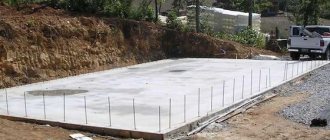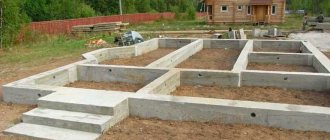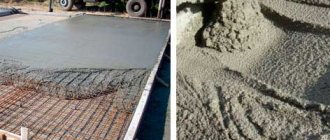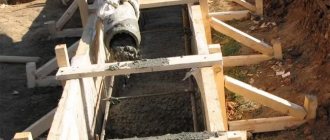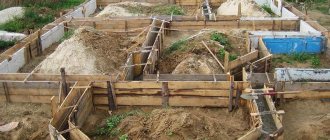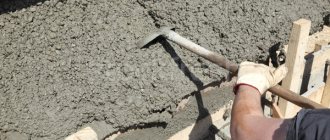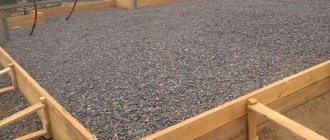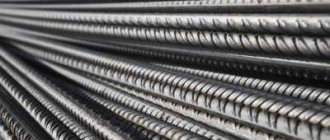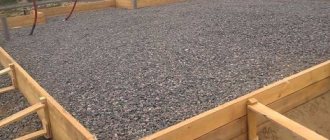But in order for the strip foundation not to fail during operation, it must be properly equipped, using high-quality reinforcement and concrete of the required grade.
We will tell you in the article which grades of concrete are best to use for the construction of a one-story and two-story private house.
Concept and classification of building material
Concrete is a high-strength building material that is used in a liquid state, and then hardens and acquires the characteristics of artificial stone. Concrete mixture is made by mixing binder, fillers, various additives and water.
Classic concrete consists of:
- sand,
- cement,
- crushed stone,
- water.
Improved versions may have an expanded set of components.
Concrete is actively used in construction and landscape creation. Depending on the purpose and operating conditions, various options for this material are chosen.
It is classified by:
- purpose - constructive and specialized with improving additives;
- density – light and heavy;
- structure – solid, porous, cellular, large-porous;
- type of filler - dense, porous, special;
- speed of strength gain;
- abrasion.
In addition, concrete is divided into classes according to the degree of water resistance, frost resistance, and workability.
Mixing in a concrete mixer
The purpose of mixing is to create a uniform layer of cement laitance around the aggregate granules. It is impossible to achieve uniformity by transferring the mixture with a shovel.
Using a concrete mixer increases the strength of the mixture by up to 40% (compared to manual mixing) - all other things being equal.
If the mixer is large (more than 300 l or 0.3 m3), lubricate the container by swirling the diluted cement-sand mixture in it for 5 minutes. Then the solution is poured out - it can be used for finishing or masonry work.
Then you can lay out the components according to plan:
- Fill in up to a fifth of the calculated volume of water.
- Add all the cement and sand and stir for about a minute.
- Add all the crushed stone in portions.
- Start pouring the remaining volume of water, ensuring uniformity and plasticity. A harsh mixture is better than a diluted one.
For a small concrete mixer, the procedure is slightly different:
- Mix all the sand with half the crushed stone without adding water.
- Add all the cement and swirl thoroughly.
- Pour in about 4/5 of the volume of water.
- Fill up the remaining crushed stone.
- If the mixture is completely dry, add the rest of the water.
For small gravity mixers, the following scheme is also used:
- Pour in part of the calculated volume of water and 1 hour of crushed stone.
- Fill in all the cement and sand.
- Add the remaining crushed stone.
- Add water (if necessary).
When it comes to mixing, longer is not better. It is optimal to unload the mixture after 2 (maximum 5) minutes. As the cycle lengthens, the water will begin to evaporate - this will result in a decrease in the plasticity of concrete and confusion with determining the volume of water for the next batches.
It makes sense to increase the mixing time to 6–10 minutes when using “stale” cement.
Brands and strength classes
Concrete is marked with the letters M and B. M is a grade of material that indicates the average load per square centimeter that a given sample can withstand when compressed until complete destruction.
The higher the number next to the letter M, the stronger the concrete. There are brands of concrete mixtures from M50 to M1000.
In construction, grades from M100 to M500 are mainly used:
M400-M500 is concrete used for the construction of bridges, tunnels, hydraulic structures and other large objects with increased strength requirements.- M400 is a material intended for industrial construction and the construction of foundations for low-rise buildings on wet and soft soils.
- M350 – used in the construction of swimming pools, multi-storey buildings, and various high-rise structures.
- M300 - used in the creation of reinforced concrete structures, as well as for the arrangement of road slabs and staircases.
- M200 – concrete for private construction. Used for the construction of light foundations and interior work.
- M100 is an auxiliary material used for preparing the foundation base, arranging drainage drains, and thin screeds.
B is concrete class . It indicates the actual compressive load that the species can withstand.
The strength class is determined by destroying a cube of hardened concrete with a side of 15 cm using a special press.
Brand and class are not the same thing. But each class has a grade that is as close as possible in strength. This is shown in the table:
| Class | Average strength (kg/cm2) | Brand |
| AT 5 | 65 | M75 |
| B7.5 | 98 | M100 |
| AT 10 | 131 | M150 |
| B12.5 | 164 | M150 |
| B15 | 196 | M200 |
| IN 20 | 262 | M250 |
| B25 | 327 | M350 |
| B30 | 393 | M400 |
| B35 | 458 | M450 |
| B40 | 524 | M550 |
| B45 | 589 | M600 |
| B50 | 655 | M600 |
| B55 | 720 | M700 |
| B60 | 786 | M800 |
The brand and class of concrete - what are the differences, the video will tell you:
Frost resistance
This indicator is marked with the letter F. It determines how much freezing and thawing concrete can withstand without more than 5% deterioration.
Different brands of concrete can undergo from 30 to 300 freezing cycles.
Waterproof
The letter W is used to indicate water resistance . It shows how much water pressure a concrete coating can withstand without allowing water to pass through the pores.
The water resistance of the material can vary from W2 to W20. In low-rise construction, materials with frost resistance up to W4 are used.
To determine the compliance of water resistance and frost resistance of concrete with grades and classes, a special table is used:
| Concrete grade | Concrete class | Frost resistance F | Waterproof W |
| m100 | B-7.5 | F50 | W2 |
| m150 | V-12.5 | F50 | W2 |
| m200 | B-15 | F100 | W4 |
| m250 | IN 20 | F100 | W4 |
| m300 | V-22.5 | F200 | W6 |
| m350 | B-25 | F200 | W8 |
| m400 | B-30 | F300 | W10 |
| m450 | B-35 | F200-F300 | W8-W14 |
| m550 | B-40 | F200-F300 | W10-W16 |
| m600 | B-45 | F100-F300 | W12-W18 |
Indicators of workability of the solution
Workability is the ability of concrete to fill the mold evenly when poured and, after compaction, to form a homogeneous dense mass.
There are three classes of concrete for workability:
- P – spreading mixtures;
- P – mobile;
- F - hard.
Within each class there is a division according to the degree of manifestation of characteristics. Thus, spreading mixtures are divided into categories from P1 to P6. The higher the indicator, the higher the ability of the material to self-fill the mold without compaction by vibration.
Mobility is indicated by the letter P. There are 5 degrees of mobility of concrete. Mobility is determined by placing concrete in a mold with a cone with a height of 30 cm, a lower diameter of 30 cm and an upper diameter of 10 cm.
The higher the number, the greater the mobility. After removing the cone, the concrete gradually loses its shape. The degree of shrinkage of the mold determines the mobility of the mixture.
Depending on how mobile the mixture is, its purpose is determined:
| P1 | Pouring concrete pads under the foundation, floor screeds, creating concrete slabs without reinforcement, foundations with a small amount of reinforcement. |
| P2 | Slab foundations with lightweight reinforcement frame, concrete beams. |
| P3 | Dimensional columns and supports, horizontal concrete structures with full reinforcement, high foundations. |
| P4 | Any reinforced concrete structures with tightly packed reinforcement, installed without vibration. |
| P5 | Structures obtained by pouring concrete with sealed formwork. |
Life time
The service life of a strip or slab foundation depends on the construction technology, as well as climatic and geological conditions. For example, some builders claim that a slab can last 100 years, and construction companies give a warranty period of 15-30 years. It is still difficult to determine exact data, since the technology for constructing the slab itself appeared relatively recently.
For “tape” the service life is a little easier to determine. For example, a brick base will last from 25 to 55 years, a concrete block base will last from 45 to 80, and a monolithic strip base can last up to 140-150 years. All these terms also depend on the integrity of the contractor, since the quality of materials plays an important role in the duration of operation.
An example of a cracked “fresh” foundationSource promid.by
Which one is better to use?
In order to choose the right type of concrete for a strip foundation for a particular building, you should take into account the characteristics of different classes and brands of mixtures. They are presented here:
| Concrete brand | Class (grade) of concrete by strength | Application of concrete |
| BSG V 7.5 F50 W2 P3 | B7.5; M100 | Used for preparatory work |
| BSG V 10 F50 W2 P3 | AT 10 O'CLOCK; M150 | For arranging strip foundations during the construction of small buildings |
| BSG V 12.5 F100 W2 P3 | B12.5; M150 | For pouring tapes under light oversized buildings |
| BSG V 15 F100 W4 P3 | B15; M200 | For grillages and screeds, as well as strip and slab supports for buildings |
| BSG V 20 F150 W4 P3 | IN 20; M250 | For monolithic foundations (strips and slabs), for pouring floors with insulation |
| BSG V 22.5 F150 W6 P3 | B22.5; M300 | Used in the construction of load-bearing reinforced concrete structures, can be used for floor screeds with a high strength index and heating |
| BSG V 25 F200 W8 P3 | B25; M350 | This material is used to create reinforced concrete load-bearing elements that will be operated under increased load |
| BSG V 30 F200 W8 P3 | B30; M400 | The foundations of cottages are constructed from this material when building on soft soil, and for the foundations of apartment buildings above 3 floors |
Concrete from M500 and above is also used in the construction of country cottages, but they are practically not used in the construction of private houses.
A trademark is a type of concrete mixture sold ready-made in construction companies and delivered to the construction site using special equipment - concrete mixer trucks. The mixture produced by the construction organization must be delivered no later than an hour and a half after mixing.
If it is possible to deliver concrete as quickly as possible, it can be delivered in a dump truck, but no more than 45 minutes should pass from the moment of mixing to unloading, since without constant mixing the concrete will set and become unusable.
During construction on a site remote from the city, where it is impossible to supply the finished mixture within the specified time frame, concrete is prepared directly at the construction site. The components are combined in such proportions to obtain a material with the appropriate characteristics.
Average prices
Prices depend on the manufacturer and may vary significantly in different regions:
| Concrete grade | Price per cube |
| M50 (B3.5) gravel | 3500-4000 |
| M100 (B7.5) gravel | 2900-4000 |
| M150 (B12.5) gravel | 3000-4200 |
| M200 (B15) gravel | 3200-4400 |
| M250 (B 20) gravel | 3200-4500 |
| M300 (B22.5) gravel | 3300-4600 |
| M350 (B25) gravel | 3800-4700 |
| M400 (B30) gravel | 3700-5100 |
| M450 (B35) gravel | 4200-5500 |
| M500 (B40) gravel | 4400-4600 |
| M550 (B40) gravel | 4200-6000 |
| M600 (B45) gravel | 4500-4900 |
| M700 (B50) gravel | 5400-5500 |
| M800 (B60) gravel | 5700-5900 |
| M100 (B7.5) granite | 3500-3800 |
| M150 (B12.5) granite | 3700-4000 |
| M200 (B15) granite | 3900-4100 |
| M250 (B20) granite | 4000-4300 |
| M300 (B22.5) granite | 4299-4400 |
| M350 (B25) granite | 4300-4600 |
Compound
In order not to understand complex technical information, two groups of concrete components can be distinguished:
- Stone skeleton. Compound of mineral elements. This is sand, which acts as a fine aggregate, gravel or crushed stone - coarse components. The stone skeleton is responsible for the bearing capacity of the foundation; it is subject to various loads. The percentage in the total composition is up to 80%.
- Active group. This includes cement. With its help, loose elements, like glue, are combined into a monolith. An adhesive mass is formed after mixing dry cement powder with water. The percentage in the total composition is up to 30% (depending on the content of the stone skeleton). Even with such a low content, it plays a major role in the formation of a monolithic base.
Which one is needed for private construction?
The brand is selected taking into account:
- soil quality,
- wall materials for the future home,
- its architectural features,
- number of storeys,
- purpose of the building (temporary building, summer cottage, year-round country house).
The heavier the building and the weaker the soil, the stronger the concrete should be. For areas with high underground flows, concrete with a high moisture resistance is needed.
Provided that the construction will be carried out on dense soil, you can select the material simply by number of floors and material in accordance with this table:
| Wall material | Concrete for a one-story building | Concrete for a two-story building |
| Brick or stone | IN 20 | B22.5 |
| Tree | B15 | B17.5 |
| Porous concrete | B17.5 | IN 20 |
Briefly about the main thing
A strip foundation is faster and easier to build than a slab foundation, and its cost is much lower. This choice is suitable for those who do not have much experience in building a foundation.
Slab foundation is the best choice for unstable seismic activity and geological conditions. Due to the “floating” base, the likelihood of its breakage is reduced.
The service life of the foundation directly depends on weather and geological conditions, as well as the quality of the material and construction technology.
Main components of homemade concrete mixture
If the mixture will be produced directly on the construction site on your own, you must adhere to the concrete manufacturing technology so that it obtains the necessary characteristics.
Cement
There are several types of cement suitable for making concrete for foundations:
- quick-hardening Portland cement;
- pozzolanic cement;
- Portland slag cement;
- Portland cement.
The most commonly used option is Portland cement. It is quite economical and has satisfactory properties. Other options are used for special requirements. Portland cement is purchased grade M400 or M500.
Sand
The sand must be homogeneous, without impurities and debris . It is better to use river sand - it is cleaner. An important parameter of sand is grain size.
When using M300 cement, you need to purchase fine sand with a particle size of about 2.5 mm. For a mixture based on stronger cement, coarser sand is needed - with a grain size of 3.5 mm or more.
Gravel or crushed stone
The base filler can be gravel or crushed stone . It is better to use gravel, as it has an optimal strength-to-price ratio. The size of the filler fractions depends on the dimensions of the foundation.
Large foundation strips are filled with concrete with a filler fraction of 10-20 mm. When arranging a shallow foundation, the gravel should be finer.
Water
Much depends on the quality of the water. It must meet the requirements of GOST. It should contain less than 5000 mg of salts per liter, no more than 2700 mg of sulfates, low acidity is needed.
You can use technical or drinking water . With an optimal salt composition, sea water is suitable. Sewage and swamp water cannot be used to create a foundation.
What else do you need to know?
Proper reinforcement will give greater strength to the foundation. For this, 12 mm corrugated reinforcement is used, and in case of heavy loads, other diameters are selected. The minimum cross-sectional area of the reinforcement should be 0.1% of the cross-section of the foundation where it is laid.
If work is carried out in the heat, the concrete is covered with heat-insulating material (rags, films, fabric, sawdust, etc.). It is advisable to water the surface several times. With increased groundwater level, the water resistance of concrete should be no less than W4. In this case, it will not lose strength throughout its service life.
When building a foundation, you cannot skimp on concrete. An incorrectly made foundation will cause constant problems both at the stage of construction and during operation.
Self-cooking
During the preparation process, it is necessary to mix the components in the correct proportions, taking into account the brand of cement used:
| Cement brand | Cement | Sand | Gravel | Water |
| M100 | 1 | 4,1 | 6,1 | 1,1 |
| M200 | 1 | 2,5 | 4,2 | 0,9 |
| M300 | 1 | 1,7 | 3,2 | 0,65 |
| M400 | 1 | 1,1 | 2,4 | 0,5 |
| M500 | 1 | 0,8 | 1,5 | 0,4 |
Mixing in a concrete mixer
If you need to mix more than 50 liters of concrete at once, you need to use a concrete mixer.
First, use a measuring bucket to pour dry components into a concrete mixer , maintaining the correct order - cement, sand, crushed stone.
All this is mixed dry for several minutes. Next, water is poured in and everything is mixed together for 12-16 minutes. The finished concrete mixture is moved into special containers and supplied to the pouring site.
Proportions in concrete for the foundation
The required proportions are determined in two ways:
- calculated - taking into account the W/C and type of aggregates, using reference tables. They start with proportions by mass, then, knowing the density, move on to volumes;
- using a ready-made mixture composition calculator;
- from ready-made tables for popular brands.
For cement PC400:
Mass ratios are needed for purchasing raw materials, and volume ratios are needed for mixing. Before adding the components to the mixer, it is enough to divide the volume from the tables by the volume of the measuring bucket.
Table for PC500:
The approximate volume of water is taken from the table of permissible W/C. Real - determined by eye, based on the plasticity of the mixture.
What brand of concrete did you buy for the foundation?
How to mix it correctly
This option will allow you to avoid delays in pouring, which can be dangerous due to the appearance of poorly connected areas. A tape with such flaws will not be able to withstand operational loads.
If you decide to make concrete yourself, you will need to prepare all the necessary components and a concrete mixer. It is not necessary to purchase it; you can rent it for a couple of days.
You will need a sieve to sift sand, which may contain various clogging elements . In private construction, it is customary to use an armored mesh from a bed, which is installed obliquely above the receiving container.
Sand is thrown with a shovel through it into a container (box or trough), debris and foreign elements remain on the mesh. The best option is washed river sand without clay inclusions.
A gravity concrete mixer is capable of producing from 60 to 500 liters of solution per batch, depending on the volume. The volume must be known in order to be able to ensure the correct ratio of components.
Frost resistance
Frost resistance is an indicator characterizing the ability of a material to withstand a certain number of freezing-thawing cycles without changing its performance. It is designated by the letter F and has a range of values from 50 to 2000 cycles.
This means that concrete of relatively weak grades can have high F values, but the probability of such a combination is very low. With a full guarantee, the expected F value can only be obtained with higher grades (or classes) of concrete.



